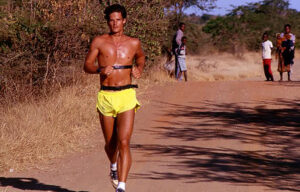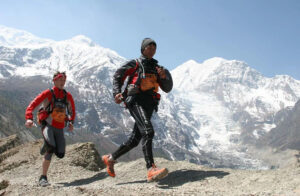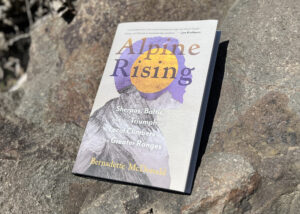Watch a grown man carrying a shovel dressed as a train engineer run a marathon through muddy swamps, dense brambles, and people’s backyards.
You read that right. The short film Run the Line depicts Beau Miles “following his nose on something half-cooked that’s only half there” — in this case, a long-abandoned train line near his home in southeastern Australia.
Miles totes no electrolyte packets, no nutritional goo, no form of instant sugar. He has no smartwatch, no system for measuring distance. He doesn’t even wear running clothes. A pair of work pants, a cutoff plaid shirt, and a scarf get the job done.
Why the shovel? According to Miles, it’s to shove aside blackberry brambles when the going gets thick. It’s a curious tool for the job, but it makes the ruddy-complected runner’s anachronistic kit uncannily complete.

Beau Miles, marathon runner-cum-train engineer.
The objective: “Run” a semi-rural 43km train line that once carried timber between Noojee and Warragul (outside Melbourne) from the early 1900s until 1958.
Beau Miles hunts history on the traces of a trail
Why pursue such a bizarre objective? According to Miles, his aim was to perform first-hand (or boots-on-the-ground) historical research.
“I think it’s easy to forget about eras before our current one,” Miles says. “Especially when they get lost under layers of new suburbs and development. There comes a time when you have to actively search out history. Running what was last run by big steel wheels — what a cool idea! At least, I think it’s a cool idea.”
Noting that the route has not existed for over 60 years, the chipper Australian understandably predicts some obstacles. Hijinks ensue.

The 43km route, which passes near Miles’ “boyhood” and “manhood” homes.
Almost as soon as he sets New Balance to train track at the station in sleepy Warragul (population 1,476), he runs into his first bottleneck: a small house, right where the track used to be.
He considers his options.
“Yeah, I don’t know,” Miles begins, “if I was sitting there having my cup of tea and a bloke wanders through looking like an idiot train driver with a shovel, I’m probably going to get up and say ‘get out of here. You’re not supposed to be here, train drivin’ man.’”

Myriad obstacles beset the marathon-distance “route.”
Trespass as exploration, and ‘bush tucker’
He resolves to go around, but it won’t be his last time weighing the pros and cons of attempting to harmlessly violate personal property. Trespassing is the zany exploit’s principal antagonistic behavior, and the marathon-distance run proves to require it on a nearly constant basis. (The film counts the last fence Miles jumps as number 176.)
“My thinking was, if I was continually moving and being mindful of the animals, I wasn’t doing anybody any harm,” he says.
At one point, the police respond to phone calls from anxious residents and conduct a notably non-threatening interrogation.

Local police interview Beau Miles. (Their dialogue in subtitle.)
The encounter tests Miles’ mettle little, if at all. He simply churns through the landscape, eating leftover mush packed in multiple upcycled peanut butter jars in his backpack. At one point, he chomps down wild mushrooms growing beside the road. “That is a good bit of mushie,” he exclaims. “A good bit of bush tucker.”
He’s delighted to discover that fence number 68 is not electric, stating, “That’s good for my balls.”
“I want to be engaged with what’s around me,” he says. “I don’t want to be distracted by the trail, or the lack of one. This is my new kind of running — which in some ways isn’t running at all. It’s exploring. And I bloody love it.”
Revelations with a magpie
Reflecting at the end of the adventure, Miles finds himself talking to a curious magpie at Noojee station. “I spent years and years going to the ends of the earth trying to find adventure,” he confides to the bird. “It’s right under my nose here. Under all these multilayered things in my own backyard.
I guess that’s the big takeaway here. Explore your own backyard.”






